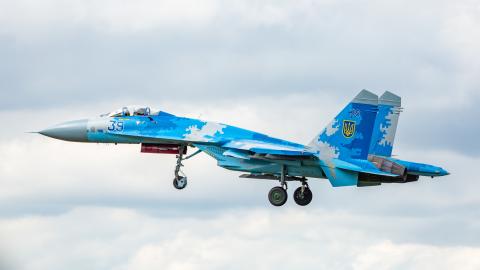More than two years into the war in Ukraine, the front lines are mostly static, at least for now. Russian and Ukrainian forces have both built elaborate defensive lines consisting of complex systems of trenches that would not have looked out of place on the Western Front during the First World War.
While these fortifications have not prevented either side from trying to attack, the few minor territorial gains have come at a high cost to life and equipment. But while on the ground the system of trenches and vast fortifications might seem like they are from a previous century, in the skies above the battlefield the future nature of warfare is rapidly evolving.
Given the difficulties in making progress on the ground, both sides have taken to the air. Over the past couple of weeks, Russia has launched hundreds of suicide drones (meaning the drone does not return to base after its mission and instead flies directly into the intended target), cruise missiles and ballistic missiles against Ukrainian targets. Targets have included civilian apartment blocks, electrical power plants and substations, and even a major dam.
Meanwhile, Ukraine has launched a steady wave of domestically produced suicide drones that have been able to strike targets deep inside the Russian Federation.
It is too early to say which side will gain the upper hand in this air war. So far, Russia has fired more than 7,000 missiles of all kinds at Ukraine. The world has not seen airstrikes at this level and intensity for decades.
In February 2022, when Russia launched its initial missile salvos against Ukrainian targets, few could have guessed that more than two years later, Russian forces would still be burning through its stockpiles at such a rate.
It has taken the Russian defense industry months to try to meet this new demand. Even so, it is estimated that Russia can only build between 115 and 130 longer-range missiles a month. In the past 10 days alone, Russian forces have fired about 120 missiles. Clearly the recent tempo of missile strikes is not sustainable for a long period of time. However, even a few dozen missiles a month can have a major impact in the absence of adequate air defenses.
While Russia might be burning through its missile inventory, its allies have been willing to help fill the gaps. There is evidence that North Korean missiles are being used to hit targets in Ukraine, for example.
There is also extensive cooperation between Moscow and Tehran when it comes to drones. Thousands of Iranian-produced Shahed suicide drones have been supplied to Russia for use in Ukraine since the war started. Last year, ground was broken on a new factory in Russia's Tatarstan region that is expected to be producing thousands of Shahed drones by 2025.
As for Ukraine, creativity, ingenuity, boldness and, above all, survival instincts have allowed it to counter Russia’s air threat fairly successfully. Ukrainians have surprised the world with the rapid development of its own drone fleet, which is able to strike targets deep inside Russia. While the exact details are not publicly known, it is thought that Ukraine has produced at least 15 different types of drones since February 2022.
Last week, the world saw firsthand the effectiveness of Ukraine’s homemade drones when they struck several Russian oil refineries. At least 13 refineries have been hit by Ukrainian drones so far this year, with the most distant target located in the Samara Oblast, about 800 kilometers from Ukraine.
The ability to hit such targets is important to Ukraine because Western sanctions have been weak in terms of cracking down on Russian oil exports. Moscow depends on oil revenue to generate income for its war chest.
Instead of relying on watered-down Western sanctions, Ukrainians have therefore taken matters into their own hands. The results of the drone strikes have already been felt inside Russia; it is estimated that 12 percent of Russian oil-refinery capacity has been put out of commission. Consequently, all Russian exports of gasoline to global markets have been halted until further notice.
Even with Ukraine’s recent successes with its drone program, however, Kyiv remains on the defensive when it comes to the air war.
The Ukrainians have done a good job of using air defense systems provided by the West, such as the patriot missile system, to counter the Russian missile threat. However, delays by the US Congress in authorizing additional aid for Ukraine mean that stocks of the interceptors needed for these systems are starting to run low. This probably explains why more Russian missiles have been hitting their targets in recent weeks.
Additionally, Ukraine has only been provided with enough advanced air defense systems to protect major cities, such as Kyiv and Odesa. Other population centers lack comprehensive air defense coverage, and soldiers serving on the front lines are suffering, too.
This year will be a race, therefore, between Ukraine’s allies to provide advanced air defense systems, and Russia’s allies to provide more ballistic missiles and drones. At the same time, Ukraine will be working overtime to expand its indigenous drone program in an effort to keep pace with Russia’s domestic missile production.
While the conflict seems to be slow-going on the ground, the ongoing barrage of missiles and drones launched by both sides serves as a reminder that it will not end any time soon.
The war in Ukraine might seem to be thousands of kilometers away from most people, but it should serve as a wake-up call for everyone. The use of drones and advanced missiles in conflicts will only increase. Policymakers must learn the lessons now to better prepare for the future.



















